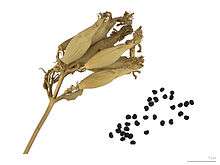Saponaria officinalis
| Saponaria officinalis | |
|---|---|
 | |
| Scientific classification | |
| Kingdom: | Plantae |
| (unranked): | Angiosperms |
| (unranked): | Eudicots |
| (unranked): | Core eudicots |
| Order: | Caryophyllales |
| Family: | Caryophyllaceae |
| Genus: | Saponaria |
| Species: | S. officinalis |
| Binomial name | |
| Saponaria officinalis L. | |
| Synonyms[1] | |
| |

Saponaria officinalis is a common perennial plant from the carnation family (Caryophyllaceae). This plant has many common names,[2] including common soapwort,[3] bouncing-bet,[3] crow soap,[2] wild sweet William,[2] and soapweed.[4] There are about 20 species of soapworts altogether.
The scientific name Saponaria is derived from the Latin sapo (stem sapon-) meaning "soap," which, like its common name, refers to its utility in cleaning. From this same Latin word is derived the name of the toxic substance saponin, contained in the roots at levels up to 20 percent when the plant is flowering[5] (Indian soapnuts contain only 15 percent). It produces a lather when in contact with water. The epithet officinalis indicates its medicinal functions.
Saponaria officinalis' native range extends throughout Europe, and in Asia to western Siberia. It grows in cool places at low or moderate elevations under hedgerows and along the shoulders of roadways.
Description
The plants possesses leafy, unbranched stems (often tinged with red). It grows in patches, attaining a height of 70 cm. The broad, lanceolate, sessile leaves are opposite and between 4 and 12 cm long. Its sweetly scented flowers are radially symmetrical and pink, or sometimes white. Each of the five flat petals have two small scales in the throat of the corolla. They are about 2.5 cm wide. They are arranged in dense, terminal clusters on the main stem and its branches. The long tubular calyx has five pointed red teeth.
The individual flowers open in the evening, and stay open for about three days.[6] They produce a stronger scent at night and supplement nectar production during the night.[6] The flowers are protandrous: on the second night of blooming, the pollen is released, and the stigma develops to its final position by the third night.[6] Much of the seed production comes from self-pollination.[6] The flowers are visited by various insects including Noctuidae, Sphingidae, bumblebees, and hoverflies.[6]
In the northern hemisphere Saponaria officinalis blooms from May to September, and in the southern hemisphere October to March.

External use
As its common name implies, it can be used as a very gentle soap, usually in dilute solution. It has historically been used to clean delicate or unique textiles; it has been hypothesized that the plant was used to treat the Shroud of Turin.[7]
A lathery liquid that has the ability to dissolve fats or grease can be procured by boiling the leaves or roots in water. Take a large handful of leaves, bruise and chop them and boil for 30 minutes in 1 pint/600ml of water; strain off the liquid and use this as you would washing-up liquid.[8]
In the Romanian village of Sieu-Odorhei, natives call the plant "Sǎpunele". It is traditionally used by the villagers as a soap replacement for dry skin.
Internal use
An overdose can cause nausea, diarrhoea and vomiting.
Despite its toxic potential, Saponaria officinalis finds culinary use as an emulsifier in the commercial preparation of tahini halva,[9] and in brewing to create beer with a good "head". In India, the rhizome is used as a galactagogue.[10]
In the Middle East, the root is often used as an additive in the process of making the popular sweet, halvah. The plant is called ‘irq al-ḥalāwah in Arabic, çöven in Turkish, and is utilized to stabilize the oils in the mixture or to create a distinctive texture of halvah.
Chemistry
S. officinalis contains the flavone saponarin.
References
| Wikiversity has bloom time data for Saponaria officinalis on the Bloom Clock |
| Wikimedia Commons has media related to Saponaria officinalis. |
| Wikispecies has information related to: Saponaria officinalis |
- ↑ "The Plant List: A Working List of All Plant Species".
- 1 2 3 "Royal Horticultural Society Plant Selector".
- 1 2 "USDA GRIN Taxonomy".
- ↑ Paul Slichter. "The Pink Family in the Columbia River Gorge: Caryophyllaceae".
- ↑ Farmakognosia, by Raimo Hiltunen (in finnish)
- 1 2 3 4 5 Wolff, D.; Witt, T.; Jurgens, A.; Gottsberger, G. (2006). "Nectar dynamics and reproductive success in Saponaria officinalis (Caryophyllaceae) in southern Germany". Flora. Morphologie, Geobotanik, Oekophysiologie. 201 (5): 353–364. doi:10.1016/j.flora.2005.07.010.
- ↑ Shroud of Turin. (PDF) . Retrieved on 2012-06-03.
- ↑ Mabey, Richard; 'Plants with a Purpose: A guide to the everyday use of wild plants', William Collins, Fontana, Glasgow, 1977
- ↑ Alice Arndt (10 August 1999). Seasoning Savvy: How to Cook With Herbs, Spices, and Other Flavorings. Psychology Press. pp. 215–. ISBN 978-1-56022-031-2. Retrieved 3 June 2012.
- ↑ Purple Sage page on Soapwort. Purplesage.org.uk (2012-04-01). Retrieved on 2012-06-03.